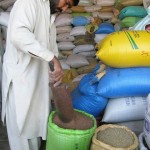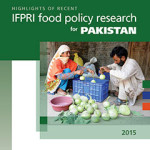Ending hunger and undernutrition are critical to poverty reduction. In order to achieve these goals, policymakers and stakeholders must look to agriculture.
Human Capital Accumulation in Pakistan
MOTIVATION Human capital is one of the most vital resources to achieve economic development and ensure food security. In the late 1980s in Pakistan, growth in the supply of educated workers was higher than the demand for them in urban areas, while at the same time, a marked increase of educated workers emerged in post-Green >> Read more
Agricultural Production Credit
MOTIVATION Since the 1950s, agricultural credit (a type of loan that helps farmers to undertake new investments or adopt new technologies) has been a mainstay in helping farmers bridge the gap between income and expenditures. Agricultural credit has been a basic component of the Pakistan agricultural policy strategy to improve investments in the rural sector. >> Read more
Pakistan’s Wheat Policy
"[There] was absolutely no need to continue the ration system to 1980s, and yet it continued. But for the IFPRI’s study, it may have continued even now." - Dr. Zafur Altaf, Secretary of Pakistan's Ministry of Food and Agriculture, Food Policy in the Dynamics of Global Agriculture, a documentary video by AGCOM International.
Comparison of Hunger across States: India State Hunger Index
MOTIVATION Since 2006, IFPRI has published the Global Hunger Index (GHI), an annual ranking and report that measures the state of hunger both worldwide and by country. In 2008, IFPRI—in collaboration with the German NGO Welthungerhilfe and Irish NGO Concern Worldwide— constructed the India State Hunger Index (ISHI) to compare hunger levels between states within >> Read more
Pulses for Nutrition in India
MOTIVATION Pulses, such as yellow peas, pigeon peas, chickpeas, lentils, and beans, are an important source of protein and are also integral to soil health. Despite their health and environmental significance, pulses are not given sufficient attention within India. IFPRI’s work on pulses, supported by A4NH, looks at the factors that contribute to their underutilization >> Read more




